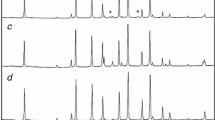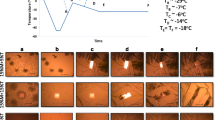Abstract
Purpose. The purpose of the study is to characterize glycine crystallization during freezing of aqueous solutions as a function of the glycine salt form (i.e., neutral glycine, glycine hydrochloride, and sodium glycinate), pH, and ionic strength.
Methods. Crystallization was studied by thermal analysis, microscopy, x-ray diffraction, and pulsed Fourier transform nmr spectroscopy.
Results. A solution of neutral glycine with no additives undergoes rapid secondary crystallization during freezing, forming the β polymorph, with a eutectic melting temperature of −3.4°C. Glycine hydrochloride solutions undergo secondary crystallization relatively slowly, and the eutectic melting temperature is −28°C. Sodium glycinate crystallizes from frozen solution at an intermediate rate, forming a eutectic mixture with a melting temperature of −17.8°C. Where secondary crystallization does not occur rapidly, a complex glass transition is observed in the −70° to − 85°C temperature range in the DSC thermograms of all systems studied. Rates of secondary crystallization and the type of crystal formed are influenced by solution pH relative the the pKs of glycine, and also by the change in ionic strength caused by adjustment of pH. Increased ionic strength significantly slows the crystallization of neutral glycine and promotes formation of the γ polymorph. Thermal treatment or extended holding times during the freezing process may be necessary in order to promote secondary crystallization and prevent collapse during freeze drying.
Conclusions. The results underscore the importance of recognizing that seemingly minor changes in formulation conditions can have profound effects on the physical chemistry of freezing and freeze drying.
Similar content being viewed by others
REFERENCES
U.B. Hansson. Inhibition and reversal of aggregation of immunoglobulin G by freezing. Acta Chem. Scand., 22: 490–5 (1968).
Y.J. Wang and M.A. Hanson. Parenteral formulations of proteins and peptides: Stability and stabilizers. J. Parent. Sci. Tech. 42S: 1–26 (1988)
K. Izutsu, S. Yoshioka, and T. Terao. Effect of mannitol crystallinity on the stabilization of enzymes during freeze drying. Chem. Pharm. Bull. 42: 5–8 (1994).
K. Izutsu, S. Yoshioka, and T. Terao. Decreased proteinstabilizing effects of cryoprotectants due to crystallization. Pharm. Res. 10: 1232–37 (1993).
M.J. Pikal, K.M. Dellerman, M.L. Roy, and R.M. Riggin. The effect of formulation variables on the stability of freeze dried human growth hormone. Pharm. Res. 8: 427–36 (1991).
L.M. Her and S.L. Nail. Measurement of glass transition temperatures of freeze-concentrated solutes by differential scanning calorimetry. Pharm. Res. 11: 54–59 (1994).
S.L. Nail, L.M. Her, C.P.B. Proffitt, and L.L. Nail. An improved microscope stage for direct observation of freezing and freeze drying. Pharm. Res. 11: 1098–1100 (1994).
L.M. Her, M. Deras, and S.L. Nail. Electrolyte-induced changes in glass transition temperatures of freeze-concentrated solutes. Pharm. Res. 12: 768–72 (1995).
M. Litowska and H. Dohler. Hydration of synthetic polypropylene phosphate (PPP)—a simplified model for natural teichoic acids. Part 3. Bound (non-freezing) water in PPP gels by the pulsed Fourier transform nmr method. Colloid Polym. Sci. 265: 106–112 (1987).
E.Y. Shalaev and A.M. Kanev. Study of the solid-liquid state diagram of the water-glycine-sucrose system. Cryobiology 31: 374–82 (1994).
T. Suzuki and F. Franks. Solid-liquid phase transitions and amorphous states in ternary sucrose-glycine-water systems. J. Chem. Soc. Faraday Trans. 89: 3283–88 (1993).
International Centre for Diffraction Data. Powder Diffraction File: Organic and Organometallic Phases Search Manual, Swarthmore, PA (1992).
Y. Iitaka. The crystal structure of β glycine. Acta Cryst. 13: 35–45 (1960).
Ahlneck, C., and Zografi, G. The molecular basis of moisture effects on the physical and chemical stability of drugs in the solid state. Int. J. Pharm., 62: 87–95 (1990).
Author information
Authors and Affiliations
Rights and permissions
About this article
Cite this article
Akers, M.J., Milton, N., Byrn, S.R. et al. Glycine Crystallization During Freezing: The Effects of Salt Form, pH, and Ionic Strength. Pharm Res 12, 1457–1461 (1995). https://doi.org/10.1023/A:1016223101872
Issue Date:
DOI: https://doi.org/10.1023/A:1016223101872




